Reducing Carbon Footprint through Rubber Cultivation
- By 0
- April 22, 2020

By Dr Sunil E Fernando
The natural rubber tree converts a greenhouse gas to a hydrocarbon. It is also capable of delivering it in commercially viable quantities almost on a daily basis, unlike any other. In addition, it retains some carbohydrates produced over a 30-year period, as medium density hardwood. This natural process of the biosynthesis of two products not only sustains the farmer, but also reduces the impact on global warming to some extent due to carbon dioxide extraction. Thus, preserving existing rubber plantations and cultivating more, especially in marginal lands, will help to mitigate an imbalance created due to the production of excessive quantities of a greenhouse gas
Benefits of Growing Rubber: Hevea brasiliensis or the rubber tree began its epic journey in 1875, when Sir Henry Wickham brought 70,000 seeds from Rio Tapajos in the upper Amazon to Kew gardens in London. Of these, 1911 seedlings were planted in Gampaha botanical gardens, Sri Lanka, initiating an agricultural revolution in South East Asia and an industrial revolution globally. Apart from giving 14 million tons of Natural Rubber (NR) consumed annually worldwide, the tree has other attributes listed below.
Extracting 24.9 kilograms of Carbon dioxide (CO2) Greenhouse gas (GHG) to produce one Kilogram of latex
Yielding 2.1 cubic meters/tree of wood from GHG as biomass, every 30-year cycle
Produce easily biodegradable litter, compared to monocultures like Teak
Require less chemical fertilisers, water and pesticides
Retains biodiversity as a tropical plant and co-exists with other species allowing for intercropping
The uniqueness of the rubber tree is its ability to fix CO2 almost instantaneously into a hydrocarbon on a daily basis, with water and energy from sunlight while nature took millions of years converting biomass to a hydrocarbon, Petroleum. The tree is a natural solar panel trapping energy from the Sun, propagating a chemical reaction giving a hydrocarbon, while releasing Oxygen to the atmosphere and accumulating a timber resource. Tapped from year 5, the tree removes a GHG every other day, unlike any other plant species, for 11 months of the year for 25 years.
Why Excess CO2 is bad
CO2 present in the atmosphere is a double-edged sword. "CO2-Earth" reports, its concentration increased from 330 ppm in 1975 to 408.55 in September 2019, and further to 410.27 in November 2019. CO2 absorbs Infrared radiation (heat radiation) from the Sun through molecular vibrations, and emit this energy unlike gases like Nitrogen and Oxygen. Ozone, Methane and Nitrous Oxide are other GHG's, which absorb energy from the sun and similarly emit heat, warming the atmosphere.
However, GHG's maintains atmospheric temperatures without converting Earth into an ice ball. Nevertheless, high concentration of GHG in atmosphere, emit more heat to sustain global warming due to an imbalance created by excessive human activity like burning fuel, rearing of cattle/sheep, giving-off excessive CO2 and Methane, respectively. Two confirmed methods to lower ill effects of GHG are, produce less and increase plant cover.
CO2 is the raw materials for all forms of Carbohydrates, Proteins and Fats produced by plants providing for growth and energy in life forms. What is alarming is the excess CO2 produced, accumulating in the atmosphere, and in Oceans. Dissolved CO2 in seawater, raises temperature and forms Carbonic acid, increasing Ocean acidification. Ocean acidification reduces the ability of sea creatures to fix Calcium as Calcium Carbonate, another form of Carbon sink.
Carbon Dioxide Accumulation Antoine Lavoisier said, in a chemical reaction matter is neither created nor destroyed. Producing GHG through human intervention, new matter is not created but it leads to an unsustainable imbalance of matter in the environment. This is what causes the problem.

Figure 1. Figure 1. Representation of the CO2 Cycle (https://serc.carleton.edu/eslabs/carbon/2a.html)
CO2 is a GHG not only produced by burning fuels and biomass. Humans exhale One Kilogram of it daily. Increase in population does not increase CO2, as exhaled balances out by inhaling. But when human population went up from 1 billion 200 years ago to 7 billion now, increase in human activity led to an imbalance in the atmosphere and the Oceans due to release of CO2 and Methane. Biomass generation too is dwindling due to the population pressure. Thus, this imbalance of accumulating matter capable of absorbing heat is the main reason for global warming.
Biosynthesis of Natural Rubber About 2000 plant species produce NR, but Hevea brasiliensis produce commercially exploitable dispersion in water as latex. The biological reason for NR production is not clear, but it may prevent pathogenic microorganisms entering the tree. Latex is found in horizontally arranged interconnected cells called laticifer, in the bark of the tree, High yielding plantations with about 400 trees per hectare have reported a production of 2500 Kg/NR /Year. The theoretical yield potential is estimated at, 7,000 to 10,000 kg/Ha/Year. A tree giving 15 to 30g of rubber per day, tapping on alternative days yields 2.2-4.5 Kg of NR per year. According to Apollo Vredestein R and D, on average 1.9 Kg of NR goes into a tire and a tree produces enough rubber to make 2 tires per year or 50 in lifetime.
Plants take in CO2 for survival. Some converts part into an edible form, as carbohydrate and fats while the rest is converted to forms like cellulose. These may end up as wood, becoming a Carbon sink for a length of time. In rubber trees, the process extends converting part of CO2 to a rubber hydrocarbon containing Carbon and Hydrogen, more akin to Petroleum. This wonder tree makes a hydrocarbon in few minutes, while nature took millions of years to convert biomass derived from CO2 to Petroleum.

and Non-MVA Pathways (Chiang. C. C. K, 2013, PhD Thesis,
the Graduate Faculty of the University of Akron).
The biosynthetic pathway for NR in Hevea begins with the monomer precursor, Isopentenyl pyrophosphate (IPP). IPP is an adduct of Pyrophosphoric acid and Isoprene monomer. However, IPP is not an uncommon material, limited to Hevea, but is formed from carbohydrates, in other plants, algae, bacteria, in mammals and humans. The formation of IPP is said to occur by following two pathways; Mevalonate (MVA) or non-mevalonate (non-MVA), deoxy-xylulose pathway. In rubber trees, breakdown products from carbohydrates like Pyruvates and Glyceraldehydes are transformed into IPP, in Cytosol in Cytoplasm/Plastids in plant cells, in several stages in the presence of many enzymes like mevalonate kinase (MVK) and mevalonate diphosphate decarboxylase (MVD). Figure 2.
Figure 2 Representation of the Formation of IPP through MVA and Non-MVA Pathways (Chiang. C. C. K, 2013, PhD Thesis, the Graduate Faculty of the University of Akron).
On isomerisation with enzyme, Isomerase IPP is converted to Dimethyl allyl pyrophosphate (DMPP). IPP and DMPP are building blocks for diverse groups of bio-molecules like Cholesterol, Vitamin K, Coenzyme Q10 (CoQ10) and Cis-polyisoprene (NR). Figure 3
Figure 3 Pathway to NR Biosynthesis

In rubber producing Russian dandelion (Taraxacum koksaghyz Rodin), enzyme transformation of sugars enrich NR formation. In the summer months, dandelions produce excess sugars and store it as Inulin. The possibility of metabolic engineering assisted enzyme degradation of Inulin to enhance production of IPP and then to NR has been explored for dandelion. Meanwhile Researchers have succeeded in decoding the Genome sequence in Hevea. This can lead to high yielding rubber clones, by locating genes responsible for biosynthesis of rubber.
Latex with 30% NR and 5% non-rubbers is produced in special cells called laticifers located horizontally and a lateral cut of the bark exposes most number, giving latex. Since the laticifer density is genotype dependant determining latex yield, it can give the direction for biologists as a selection marker for high yielding clones. In older rubber trees chemicals inducing Ethylene formation in the bark-tissue or generated it in situ like 2-Chloroethylphosphonic acid, are used as yield stimulants. Such developments, together with appropriate nutrition infusion, can increase NR yields, making rubber cultivation attractive to farmers.
Chloroethylphosphonic acid
Hevea brasiliensis is a dual-purpose tree, making Carbon sinks from CO2 in two ways, as a hydrocarbon and as wood, extracted in a 30-year cycle. Plants like wheat and rice also fix CO2 to give edible Carbohydrates, often twice a year. Nevertheless, human/animal consumption of edible carbohydrates quickly gives CO2 back to the environment. Thus with respect to environmental benefits, producing NR by growing rubber trees is a more favourable option. Fortunately, rubber cultivation has increased from 9.9 in 1975 to 14.0 million hectares in 2018 giving these benefits worldwide.
Preserving and enhancing rubber cultivation
The rubber farmer does a silent service by extracting latex and thus removing substantial quantity of GHG on a daily basis. As NR based products stay longer in service, Carbon in it remains intact for a longer period without burdening the environment. Each tree has the uncanny ability to function as a tap, working 150 days a year to clean up the environment unlike other plant-based options. It leaves a raw material as timber derived from GHG, extracted in every 30-year cycle giving 50 Kg of wood/tree. The global potential for wood at a replanting rate of 3% of acreage annually is, approx 7.30 Mn Tons/ year.
The environmental benefits can be maximised if the farmer taps the tree every other day for 11 months of the year if their livelihood is secularly safeguarded. Going into alternatives for from existing land is counterproductive to the environment. The negative process will occur only if the farmer finds the daily sustenance by growing rubber becomes a hard task. To encourage the farmer, requires a collective and a concerted effort from:
Buyers giving stable/reasonable price
Biologists developing fast growing, high yielding, drought and disease resistant trees
Cultivation experts developing new and less-laborious extraction techniques and attractive intercropping practices
Technologists adding value to existing NR products and developing new products
• Chemists by modification to give new elastomeric materials from NR as raw materials for other processes
• Environmentalists by increasing international awareness of the benefits of growing rubber
With respect to increased appreciation of the capability of modified NR forms, an enterprising tire manufacturer uses Epoxidised NR/Silica combination in automobile tire treads, to give higher wet grip and low rolling resistance tires. Such greener tires used in hybrid and electric cars, made these vehicles more environmental friendly. Olefinic elastomers like NR, contains reactive double bonds with potential to be modified as raw materials in many applications. Table 1, Figures 4 and 5. Such developments will give impetus to the sustainability and growth of an industry, benefitting the rubber farmer while fixing more GHG as well.

(Polgar. L.M, ‘Chemical modification of hydrocarbon elastomers, Progress in Polymer Science, 2016)

showing New Products Potential
(Polgar. L.M, ‘Chemical modification of hydrocarbon elastomers, Progress in Polymer Science, 2016)
ENDS
References:
1. Bhowmik. I (2006), Tripura Rubber Mission Technical Bulletin 2. https://www.co2.earth/
3. Rao. P. S, et.al (1998), Agricultural and Forest Meteorology 3, 90
4. Chiang. C. C. K (2013), Natural rubber biosynthesis, PhD Thesis, The Graduate Faculty of The University of Akron, USA 5. Decoding the rubber tree genome, https://www.sciencedaily.com/releases/2016/06/160624100225.htm
Dr Sunil E Fernando is Former Executive Director, DPL Group, Sri Lanka, Managing Director Dipped Products (Thailand) Limited, Former Director, DPL Plantations and Kelani Valley Plantations Limited, Sri Lanka, and a Consultant - Latex Products
Birla Carbon Secures Platinum Medal In EcoVadis Sustainability Rating
- By TT News
- December 27, 2025
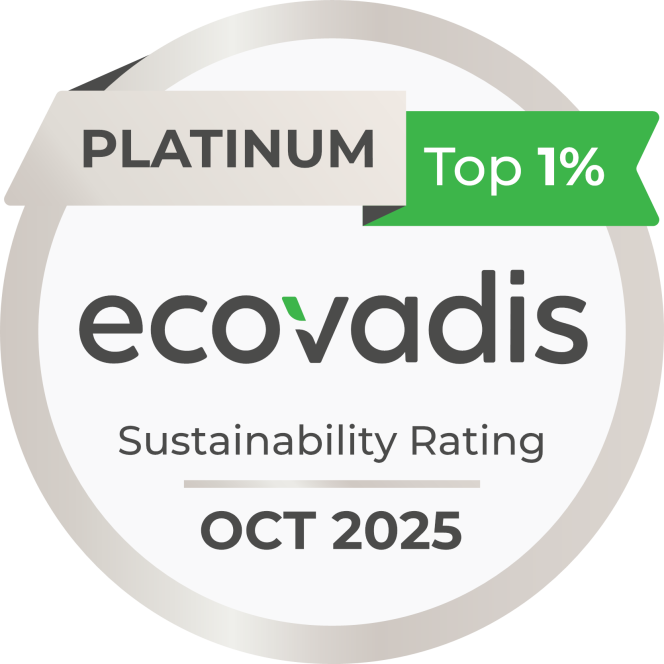
Birla Carbon, a leading global manufacturer and supplier of high-quality carbon materials, has been awarded the prestigious Platinum sustainability rating by EcoVadis, ranking it within the top one percent of all assessed companies globally. This honour recognises the firm’s enterprise-wide leadership in integrating sustainability across its operations, innovation and value chain.
The evaluation specifically commended its strong performance across four key areas: Environment, Labor & Human Rights, Ethics and Sustainable Procurement. This achievement is further validated by extensive third-party certifications, with over 75 percent of operations certified to international standards including ISO 14001, ISO 50001, ISO 45001, SA8000 and ISO 27001, underscoring the consistency and strength of its sustainability management systems.
John Loudermilk, President and CEO, Birla Carbon, said, “This Platinum rating reflects the steady progress we are making in embedding sustainability at the core of our business. Our growth strategy is geared towards delivering sustainability through innovation, operational excellence and responsible practices across our global footprint. We continually invest in sustainability and circularity-driven processes, keeping our operations sustainably efficient while creating long-term value for our customers, partners, communities and employees. Our sustainability strategy, Share the Future, serves as a roadmap to a sustainable future and guides our actions towards our aspiration of reaching net zero carbon emissions over the next 25 years. Being recognised among the top one percent of companies globally is a testament to the commitment of our teams worldwide.”
Yokohama Rubber And RAOT Hold 10th Joint Seminar For Thai Natural Rubber Farmers
- By TT News
- December 26, 2025
The Yokohama Rubber Co., Ltd. recently conducted an educational seminar for local natural rubber farmers in partnership with the Surat Thani branch of the Rubber Authority of Thailand (RAOT). This marked the 10th such event since the programme's inception in 2020, involving 50 local farm households. Attendees received complimentary fertiliser, developed with RAOT's expertise, as part of the ongoing support.
The seminar curriculum covered essential agricultural topics, including soil and plant nutrition, correct fertiliser application and methods to prevent contamination in natural rubber. To commemorate the 10th seminar, the programme was expanded to include guest speakers from local government, police and healthcare. These guests addressed broader community and safety issues, such as human rights for foreign and minority workers, road safety and occupational health. A particular focus was placed on practical well-being, with the local hospital director offering guidance on preventing injuries during tree tapping and managing encounters with poisonous insects.
Post-event feedback from participants was overwhelmingly positive. Many expressed that they gained new, systematic knowledge about cultivation practices, despite years of experience. Several noted that hearing directly from a rubber manufacturer reinforced the critical importance of purity in their product. Others found the health and safety advice immediately useful. The engaging delivery of the seminar was also highlighted, with one farmer mentioning a desire to recommend the valuable and enjoyable experience to peers.
This initiative is a direct implementation of a memorandum of understanding (MoU) signed between Yokohama Rubber and RAOT in January 2020. The MoU focuses on economic support for farmers and improving supply chain traceability, aligning with the company's Procurement Policy for Sustainable Natural Rubber. Hosted in the region where Yokohama’s Thai natural rubber processing subsidiary, Y.T. Rubber Co., Ltd. (YTRC), operates, the seminar exemplifies the policy's guideline to support small-scale farmers within the supply chain.
As a founding member of the Global Platform for Sustainable Natural Rubber (GPSNR), Yokohama Rubber is committed to advancing these principles. The company views such efforts as integral to creating shared value under its sustainability slogan, ‘Caring for the Future’, and contributes to broader United Nations Sustainable Development Goals through the promotion of sustainable raw material procurement.
Rubber Research Institute Of India Develops Latex-Based Paint
- By TT News
- December 26, 2025
In a significant event for India’s rubber sector, Minister for Ports, Co-operation & Devaswoms V N Vasavan inaugurated a ceremony for the transfer of innovative latex-based paint technology. This eco-friendly paint, a product derived from natural rubber, was developed by the Rubber Products Incubation Centre of the Rubber Research Institute of India. The technology was formally handed over to Kerala Paints Industries Private Ltd., with the Minister highlighting the event's historic nature for launching a sustainable product and stressing the importance of increasing domestic natural rubber consumption to improve grower returns.
Rubber Board Executive Director M Vasanthagesan outlined the centre's role in converting research into market-ready goods, reaffirming the Board's dedication to creating innovative, value-added rubber products. The gathering also heard remarks from several key figures, including Mahatma Gandhi University's K V Dayal, RRII Director Dr Debabrata Ray, RRII Senior Scientist Dr Shera Mathew and Kerala Paints' Managing Director Midhun P Pullumettel.
- Association of Natural Rubber Producing Countries
- ANRPC
- Natural Rubber
- Monthly NR Statistical Report
ANRPC Publishes Monthly NR Statistical Report For November 2025
- By TT News
- December 22, 2025
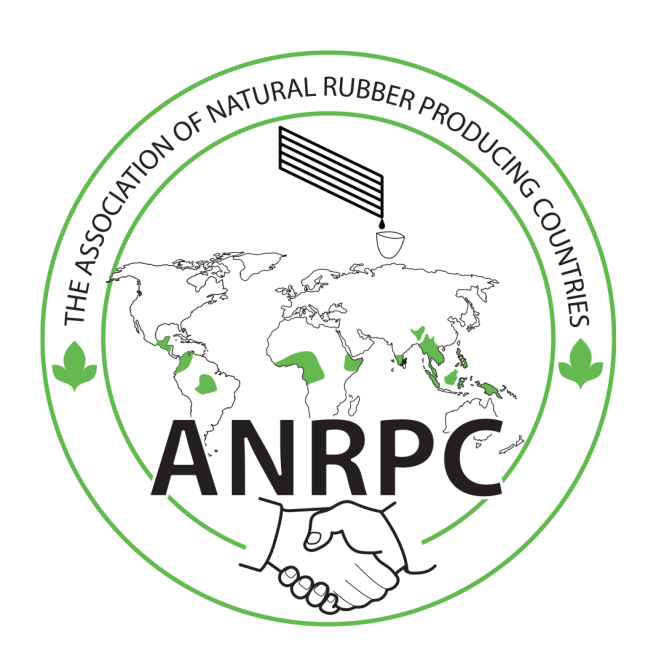
The Association of Natural Rubber Producing Countries (ANRPC) has released its Monthly NR Statistical Report for November 2025, providing an overview of key developments in the global natural rubber sector.
While a modest rise in global production of 1.3 percent is anticipated for the year, this follows a revised, lower output forecast for Indonesia. Concurrently, worldwide demand is projected to grow by a more subdued 0.8 percent, bolstered by an upward adjustment in Indonesia's own consumption figures.
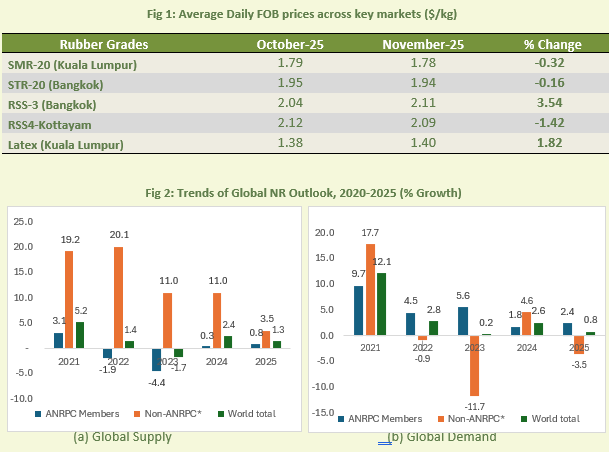
Recent price pressures have emerged due to this combination of uncertain supply, influenced by unpredictable weather patterns and generally muted demand. However, there are sporadic positive indicators, including noticeable recoveries within the tyre sector across some regional markets.


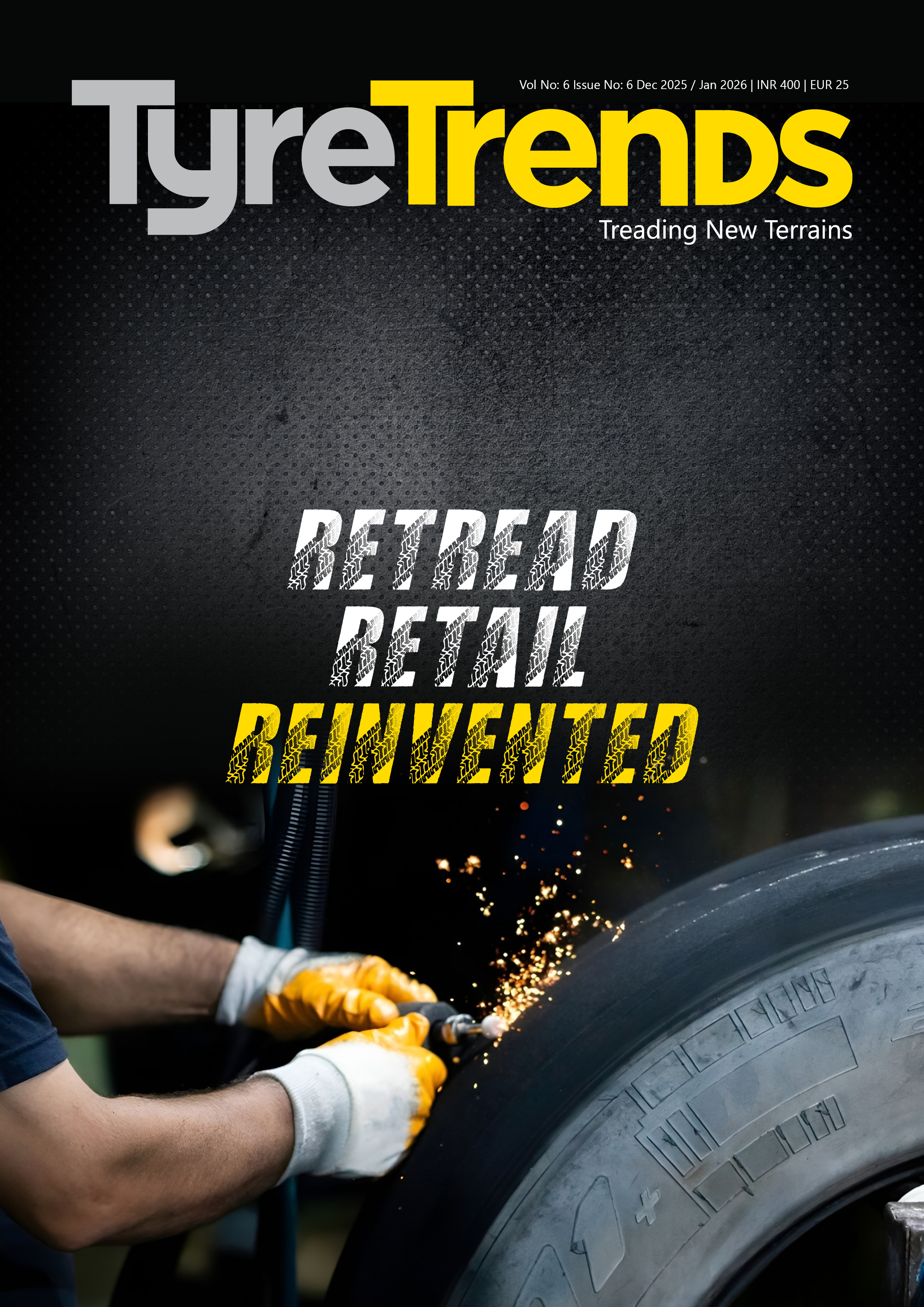



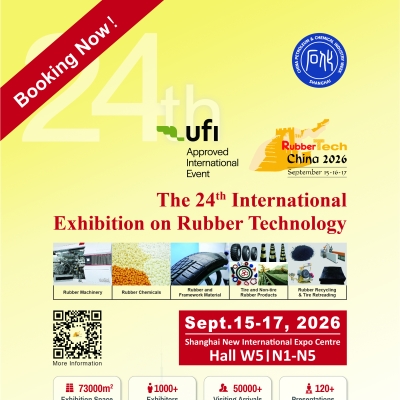
Comments (0)
ADD COMMENT